Team Members : Mahesha N, Rakshithkumar B., Shivamurthy, Yashwantha Kumar K.M
Project Guide : Dr. B R Narendra Babu, Mechanical Engineering Department, VVIET, Mysuru
Aim: Modify and to develop the painting system of a railway bogie springs by adopting pneumatic operated table for lifting of the springs
Objectives:
- To achieve improvement in financial performance.
- Increase the traffic carried in respect of passengers as well as goods.
- To improve the quality of service.
- Infrastructure Augmentation.
- Enhance safety and security.
- Green initiatives and efficient energy management
Abstract of the project:
The purpose of this project is to modify and to develop the painting system of a railway bogie springs by adopting pneumatic operated table for lifting of the springs. Earlier the springs are dipped in red oxide pool and then it is lifted up. After this it is manually loaded to dry the red oxide paint by heating. After the first round of paint is dried again it is coated with black paint. This entire process completely done manually, hence it is time consuming and requires more man power. To increase the productivity and reduced man power, we are planning to modify the old system by adopting pneumatic operated table to lift the spring and then it is loaded to roller operated conveyor for easy movement of the spring in to pencil heater. Pencil heater it is heating device, which heat the article up to 600ᵒ C.
Team Members : Dinesh M, Manoj Kumar K H, Pramodh S,Nikhil Gowda H U
Project Guide : Dr. Keerthiprasad K S
Aim: This project aims at designing and prototyping a cost-efficient threshing machine of ragi which would cater the needs of people in the rural society.
Objectives:
- The thresher uses non-polluting resource and so it is eco-friendly. It can be customized as the requirements of available resources it suits the farmer.
- Development of power operated prototype thresher for whole crop Finger millet.
- Performance and evaluation of developed prototype thresher.
Abstract of the project:
Available evidence suggest that the mode of threshing finger millet is by traditional method like beating with sticks, rubbing and trampling finger heads under bullocks feet or men feet. Traditional method is time wasting, energy sapping and often the grains or broken. Motor driven operation is one of the efficient way. The machine basically consists of four major components: feeding, threshing, cleaning and power transmission mechanism. The developed millet thresher has the ability to winnow the premature grains and leaves, which are often lighter, thus leaving aside the massy grains that, will be collected. It is beneficial for formers with reduce time of operation, reduction in breakage of grains and separation of the stalk from the grains.

Team Members :Dinesh M, Manoj Kumar K H, Pramodh S, Nikhil Gowda H U
Project Guide : Dr. Keerthiprasad K S
Objectives:
- The main objective of this project is to removal of moisture content from solid food particles.
- To develop the model of fluidized bed dryer.
- To test the developed model and compare the result with normal conventional sun drying technique.
Abstract of the project:
A fluidized bed is a physical phenomenon occurring when a quantity of a solid particulate substance is placed under appropriate conditions to cause a solid/fluid mixture to behave as a fluid. This is usually achieved by the introduction of pressurized fluid through the particulate medium. The resulting phenomenon is called fluidization. The experimental evaluation of a hot air fluidized bed dryer for wet granules presented in drying chamber. Drying chamber of fluidized bed dryer consists of three fine-meshed treys placed at a particular distance and having passage for air flow. Air flow is regulated by centrifugal blower powered by an electric motor, an air heating coil with a thermostat for selection of drying temperature of the fluidizing medium. A bed of wet solid particles were fluidized at different air flow. The resident drying time for particles in the dryer was found to be decrease with increase in drying temperature. The heat source for drying came slowly from the heated fluidizing air. It was also found that the drying rate decreases with increase in air flow rate while it increases with drying temperature.
Team Members :Suman Nagaraju S, Vishal R Kulkarni, Pavan Kumar C B, Vinod Kumar.M
Project Guide : Prof. S S Chikkadevegowda
Aim: To study the mechanical properties of MMC
Objectives:
- Identify the matrix materials by literature survey.
- Identification of gap of reinforced material by literature survey.
- Identification of casting technique casting the given aluminium metal matrix composite by stir casting technique
Abstract of the project:
In the present industrial scenario, composite materials are given first preference due to its high strength and less weight ratio. The current workfocuses on the metal matrix composites, which are mainly usedin aeronautical and automobile applications. Now a day’s metal matrix composites plays vital role in engineering applications. The Purpose of this work is to study about the mechanical properties and wear characteristics of as cast silicon carbide (SiC) reinforced aluminium matrix composites (AMCs). Silicon carbide is added as reinforcement in to Aluminium alloy (Al6061) for preparing metal matrix composite.AMCs of varying SiC content (0, 4, 8 and 12 wt. %) was prepared by Stir Casting method. This method is comparatively less expensive and very effective. The composites are fabricated by varying the SiC reinforcement from 0% to 12%. Four samples of the composite materials have been prepared As per the ASTM standard for tensile, compression, hardness and Impact testing. Then the tensile and compression test was carried out for all the specimens using the Universal Testing Machine andresults are obtained. The hardness of the specimens were also found using Brinell hardness tester.The impact strength test for all specimens using the charpy test. Fromthe results obtained, the influence of Sic reinforcement on the mechanical properties is known.The results showed that introducing Silicon Carbide (SiC) reinforcements in Aluminium (Al) matrix increased hardness and tensile strength.
Team Members :Darshan Kumar P N, Ramesh Kumar T N, Sunil Kumar M S, Sharath M S
Project Guide : Prof. Naveed Anjum
Aim: To find effect of coefficient of friction vary with respect to angle of texture.
Objectives:
- Effect of transfer layer by surface texture of different roughness.
- Influence of roughness on angle of texture.
- Fabricating fixture and pin material
Abstract of the project:
Surface texturing plays an increasingly important role as it can directly influence the friction and wear behaviours of contact surfaces. In the present investigation, by using pin on plate inclined sliding tester how surface parameter i.e., angle of texture effect variation of coefficient of friction and transfer layer has been studied.For this purpose Fixture is used to create different angle of texture on surface. The textured surface roughness is valued through optical profilometre. Pin materials made up of Aluminium(Al), Polypropylene(PP), Ultra-High Molecular weight Polyethylene (UHMWPE), Teflon is used. Tangential load is given to steel plate and normal load is kept constant for a particular value the workpiece slide to start. The Steel Plate of having different angle of Textureslides against the pin material. When it slides the tracks are formed. By counting the number of turns coefficient of friction can be found out. This procedure is carried out for all the 4 pin material respectively. The tracked formed is observed in optical microscope and image is captured.

Team Members :Santhosh Badai, Veerendra C S, Yashwanth Patil B S, Rakesh Kumar N
Project Guide : Prof. Allwin Y R
Aim: Resistance furnace while environmentally-friendly electricity cost is higher, if resistance furnace for industrial manufacturing for a long time will certainly increase the cost of power distribution equipment, thereby increasing the production costs of equipment, if we can solve the problem of high cost of electricity, electric resistance will become one of the industry's best equipment.
Objectives:
- Due to resistance furnace equipment faster than traditional fuel furnace, high temperature, easy to control, so the easy formation of mechanization and automation of the production process in the production model. Nowadays, we have rarely seen in the market drive fuel furnace, most of the equipment has been replaced by a more appropriate market development of electric resistance furnace.
Abstract of the project:
Casting is an ancient technique used for making various parts. There are various types of furnaces used for melting metals and alloys, working on different principles. In this work, an electrical resistance based low-cost furnace is planned to fabricate for melting metals. The objective is to design and fabricate an electrical metal melting furnace of 3.5 kW rating with operating temperatures up to 10000C. Further, the furnace was aimed to be able to hold the melt for required amount of time. Both electrical and mechanical aspects of furnace design were presented. Finally, the fabricated furnace operation as discussed and its heating performance was tested by melting aluminium. Its operation was discussed to suit the heating requirements for various metals and alloys.
Team Members :Bidappa M S, Chethan M, Ricky Kuttaiah M M
Project Guide :Prof. Mahesh Mudhol M
Aim: Refurbishment of hydraulic operated portable compression moulding machine for thermoset based polymer composites.
Objectives:
- Refurbishment of portable hydraulic operated compression moulding machine with controlled pre-heating setup.
- Portable compression moulding machine with simple elements like wheels for easy handling.
- Meant for secondary operation after hand layup method to prepare high strength parts.
Abstract of the project:
Compression moulding is a popular manufacturing technique for composite parts. In particular, the development of high-strength sheet moulding compounds drove wide adoption of compression moulding process in automotive and appliance applications. Introduction of moulding materials for compression moulding such as sheet moulding compound and bulk moulding compound are also available in the market. The presently various compression moulding machines are available in different capacities & setups to obtain products of dimensional, as it is important to optimize mould design and processing conditions, but still there is a gap in manufacturing portable machine with setups of under such categories of machines for fabrication of polymer-based composites. Thus, our project work focuses on design and fabrication of a portable hydraulically driven compression moulding machine with preheat set up, that acts as a secondary step after the thermoset based composites are been first fabricated by hand layup technique followed by compression moulding step so that uniform load is ensured and proper distribution of matrix system can take place, thus dimensional stability can be achieved.
Team Members :Bidappa M S, Chethan M, Ricky Kuttaiah M M
Project Guide :Prof. Mahesh Mudhol M
Aim: Refurbishment of hydraulic operated portable compression moulding machine for thermoset based polymer composites.
Objectives:
- Refurbishment of portable hydraulic operated compression moulding machine with controlled pre-heating setup.
- Portable compression moulding machine with simple elements like wheels for easy handling.
- Meant for secondary operation after hand layup method to prepare high strength parts.
Abstract of the project:
Compression moulding is a popular manufacturing technique for composite parts. In particular, the development of high-strength sheet moulding compounds drove wide adoption of compression moulding process in automotive and appliance applications. Introduction of moulding materials for compression moulding such as sheet moulding compound and bulk moulding compound are also available in the market. The presently various compression moulding machines are available in different capacities & setups to obtain products of dimensional, as it is important to optimize mould design and processing conditions, but still there is a gap in manufacturing portable machine with setups of under such categories of machines for fabrication of polymer-based composites. Thus, our project work focuses on design and fabrication of a portable hydraulically driven compression moulding machine with preheat set up, that acts as a secondary step after the thermoset based composites are been first fabricated by hand layup technique followed by compression moulding step so that uniform load is ensured and proper distribution of matrix system can take place, thus dimensional stability can be achieved.
Team Members :Siddesha Naik, Sachin R, Ajaykumar K, Sachin Yadav G.T
Project Guide :Prof. Manohar V
Aim:Optimization of gas production
Objectives:
- Comparison with conventional plants
- Effect of different parameters viz.Temperature & PH
- Total & volatile solid concentration - Alkalinity & C:N Ratio
- To increase the production by using - Additives, Nutrients, Nitrogen source Check optimization of gas production at lab scale and field scale.
Abstract of the project:
The gasses that are released during the decay of biodegradable wastes can be captured for the economic utility and as well as to save the environment. An attempt is being made in this project to demonstrate the possibilities energy recovery from biodegradable kitchen waste that is collected from canteen which can be utilized for the benefits of the canteen. Kitchen and food waste collected from canteen is analysed for the quantification of biogas. Biogas is captured through a fabricated anaerobic digester. Experimentation and results are discussed. The results are encouraging.
Team Members : Manjunath S K, Mohammed Sameed, Puneeth P Bhat, Rakshith R
Project Guide :Prof. Sandeep B
Aim:Fabrication of Natural – Polymer hybrid composite using natural reinforcement as hemp cloth and synthetic fiber as S-glass with filler as untreated Sea Shell particles with the matrix material as epoxy by hand lay-up method.
Objectives:
- To Characterize the Mechanical & Tribological properties of developed Natural – Polymer hybrid composites.The developed material will be checked for its suitability for the usage as a Brake Pad Material under prescribed testing conditions for automobile application.
Abstract of the project:
The hybrid composite materials have wide engineering applications which improves strength, impact resistance, corrosive resistance and more reliable. They form heterogeneous structures which meet the requirements of specific design and function with desired properties, as the incorporation of several different types of fibers into a single matrix has led to the development of Hybrid composites. There is need of natural fibers, which offers cost savings, reduction in density and easy decomposing. Composites with different fiber orientation, matrices and constituents would result in different mechanical properties. Presently the project involves, experimental study, which aims at: The development of Hybrid composites using Hemp cloth, which is a natural reinforcement with S glass fiber as a synthetic reinforcing material with addition of natural filler with varying weight percentage along with the matrix system as epoxy resin will be fabricated using hand layup technique for the development. The developed hybrid composites will be investigated for its Mechanical and Tribological properties. The developed material will be checked for its suitability so that it can be used for brake pad material as a part of automobile application.
Team Members : Abhijeet Singh, Sai Karthik M M, Sushruth Kashyap M, Yashwanth Athreya S
Project Guide :Prof. Sandeep B
Aim:Fabrication of hybrid composite consisting of Kevlar and C-glass fibres reinforced epoxy, a thermoset polymer based material system by Hand layup method.
Objectives:
- To study the Mechanical Behavior of developed Hybrid composites as per ASTM standards.
- To study the surface morphology using SEM technique.
- Assessment of developed material for its suitability for the usage as an energy absorption tube under prescribed testing conditions for transportation safety application.
Abstract of the project:
The use of hybrid composite in energy absorption tube application has gained importance for structural crashworthiness in transportation industry. Thus, the approach of this project is to understand the effect in hybridization within synthetic fibers being reinforced with polymer based composite.The mechanical characterization of these materials will be carried out in order to understand the material behavior when used for energy absorption characteristics and crashworthiness in theenergy absorption tube. In order to develop hybrid composites, important aspects needs to be considered such as, effectin fibre arrangement, type of polymer matrix, proportion to be followed in matrix system and technique of fabrication to produce energy tube should be known. To assess its usefulness, first the hybrid will be fabricated by hand layup technique and followed by mechanical tests, which will be conducted as per standards for the understanding of material system and further checked for its usein transportation safety applications. Moreover, in the recent studies there have been many of the research findings regarding the materials used for energy absorption tube under the polymer based composites. Therefore,effect of material hybridization will lead to another attempt to develop newer composition in composites that may have improved energy absorption capacity and moreover it gives newer areas for development for future potential as new hybrid composite materials can be employed for high-performance energy absorption tube application in transportation safety.
Team Members : Akshay C A, Praveen Laxman Kallur, Guru Prasad .S, Kiran.R
Project Guide :Prof. Gurushree M N
Aim:Perform TIG welding on SS304 material
Objectives:
- To study the parameter of TIG welding.
- To analyze better welding process for stainless steel for thin metal.
- To perform DT & NDT test on welded material.
- To measure tensile strength, impact & hardness of welded joint.
Abstract of the project:
The use of hybrid composite in energy absorption tube application has gained importance for structural crashworthiness in transportation industry. Thus, the approach of this project is to understand the effect in hybridization within synthetic fibers being reinforced with polymer based composite.The mechanical characterization of these materials will be carried out in order to understand the material behavior when used for energy absorption characteristics and crashworthiness in theenergy absorption tube. In order to develop hybrid composites, important aspects needs to be considered such as, effectin fibre arrangement, type of polymer matrix, proportion to be followed in matrix system and technique of fabrication to produce energy tube should be known. To assess its usefulness, first the hybrid will be fabricated by hand layup technique and followed by mechanical tests, which will be conducted as per standards for the understanding of material system and further checked for its usein transportation safety applications. Moreover, in the recent studies there have been many of the research findings regarding the materials used for energy absorption tube under the polymer based composites. Therefore,effect of material hybridization will lead to another attempt to develop newer composition in composites that may have improved energy absorption capacity and moreover it gives newer areas for development for future potential as new hybrid composite materials can be employed for high-performance energy absorption tube application in transportation safety.
Team Members : Naveen M.N, Pattar Aditya V, Sachin Sahapur, Sachin Sahapur
Project Guide :Prof. P Bharath
Aim:To Fabricate footstep air cooling system as prototype.
Objectives:
- To evaluate the performance, efficiency of air cooling system by different number of strokes and deflections of footsteps.
- Eco-friendly Air cooling system.
- To save electric energy used by Air-cooling system.
Abstract of the project:
Global warming is increasing day by day which leads to increase in surface temperature of earth, that has made humans to use Air Cooling systems, which are expensive and also harmful to the environment. Thus, the main concept of this project is to make low cost and environmental-friendly air cooling system in which compressed air is produced by human footstep where, force is generated by continuous walking of humans over the selected platform. This setup compresses the spring where the force energy is converted into compressed air with the help of piston cylinder mechanism. This compressed air is stored in tank, Air is further cooled by passing it through radiator in which coolant is also passed. This process reduces the temperature of air below room temperature and it is supplied to the required enclosed area. This method is nonconventional as no fuel or electric energy input is required and is pollution free
Team Members : Sufiyan Khan , Manjunatha K, Drupad Kumar
Project Guide : Dr. N. S. Sriram Professor and Dean, Mechanical Engineering Department, VVIET, Mysuru
Abstract of the project:
Packaging is the science and technology of enclosing or protecting products for distribution, storage, sale, and use. Packaging also refers to the process of design, evaluation and production of packages. Packaging contains, protects, preserves, transports, informs, and sells. It is fully integrated into government, business, institutional, industry, and personal use. They usually consist of a trough or tube containing either a spiral blade coiled around a shaft, driven at one end and held at the other, or a "shaft less spiral", driven at one end and free at the other. The rate of volume transfer is proportional to the rotation rate of the shaft. In industrial control applications the device is often used as a variable rate feeder by varying the rotation rate of the shaft to deliver a measured rate or quantity of material into a process. Initially, major specification of the equipment, like volume/weight of the granules to be handled was arrived at to decide on the size and specifications, like diameter and pitch of the auger, keeping in mind the density of the granules to be handled. The speed of the motor required to operate the auger was derived based on quantity and discharge of the auger per revolution and also calculations were carried out to determine the torque requirement for sizing the motor. From the available range of standard motors, a suitable motor was selected and coupling mechanism of the same with the auger screw was designed with necessary antifriction bearing block. This resulted in the smooth running of the screw unit for continuous positive dispensing of the granules.
Cost of the project: Rs.15,000 /-
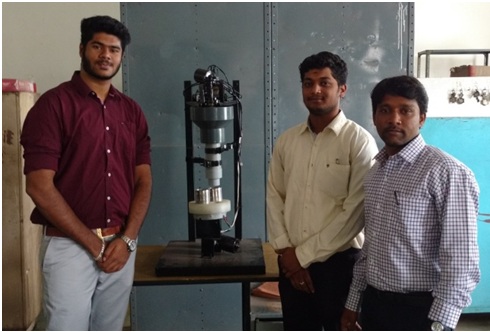
Team Members :Ikenna W, Nandisha P, Prinutha P
Project Guide : Prof. Mahesh Mudhol Assistant Professor
Abstract of the project:
India has always reigned supreme in the production and export of the most exotic and sought-after spice Pepper. Indian pepper had a profound influence on the European economy of the middle Ages. Many western countries owed their prosperity to this spice, which fetched them a very high price. However, the separation of pepper berries has always been a manual process carried out by stamping on the berries of pepper by foot. In this project, the Decorning (threshing) of pepper spikes using a mechanized system was performed and the effect of the same was discussed. The aim of the project was to provide a mechanized method for the separation of pepper berries from the spike. This can be done either manually using a chain drive mechanism or automatically with the help of a belt drive and motor arrangement. The knowledge obtained can aid in the cost-effective design of a mechanized thresher system to replace the traditional method, to reduce the cost of pepper by reducing the overall processing time.
Cost of the project: Rs.11,770/-
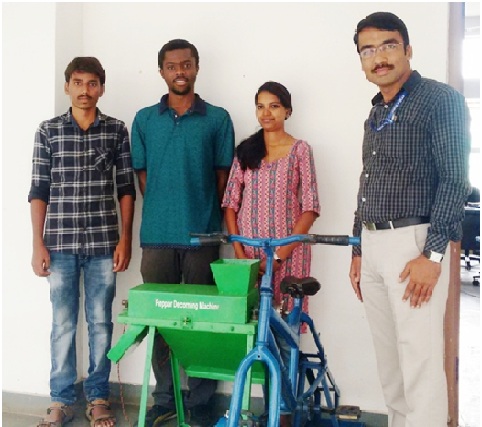
Team Members : Ananda A S, Mahadev Swamy H S, Shashikumar M C, Vijay Kumar M
Project Guide : Mr. Bharath Shekar H. R, Assistant Professor
Abstract of the project:
Electric furnace is used for heating purpose in various industrial production processes. Electric furnaces are used where more accurate temperature control is required. There are three types of electrical furnaces namely: Induction Heating Furnace, Resistance Heating Furnace and Arc furnace depending upon the method of heat generation. The scope of this work is confined to design and fabrication of resistance heating furnace only. In resistance heating furnaces, the resistance heating elements are used to generate the heat in a heating chamber. The heating element used here is Kanthal wire. The unit fabricated in this work generates heat to obtain a maximum temperature of 12000C. The temperature is controlled using thermostats and the temperature is monitored by thermocouples. The heating chamber is constructed by refractory bricks and for thermal Insulation fire clay bricks are used. Furnace is covered by mild steel sheets. Temperature distribution along the furnace wall is also determined using ANSYS. Further, characterization of Aluminium-silicon alloy is carried out for different silicon percentage (8, 12 and 18 percent). The Aluminium-silicon alloys are melted in the fabricated furnace and molten metal alloy is poured in to a mild steel die to cast test bars. Then tensile, compression and hardness tests are performed in order to analyze the properties of the cast specimens. Results show that as silicon content increases, the alloy becomes harder and less ductile.
Cost of the project: Rs.35,000/-
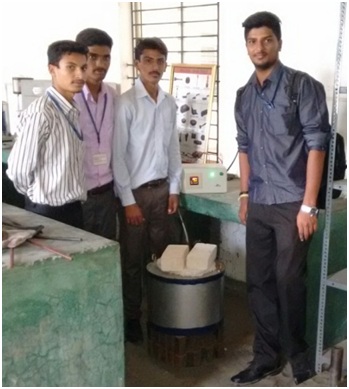
Team Members : Rakesh Y, Ravikiran K, Salman Khan ,Suraj S
Project Guide : Mr. Harshavardhan B, Assistant Professor
Abstract of the project:
This project aims at the development of a pedal operated hacksaw vehicle to fulfill the transport and power needs in rural communities in India. This portable pedal operated hacksaw machine using Trike (tricycle) can be used for industrial applications and household needs where electricity is not available. Main advantage of using trike is to carry the whole mechanism to the place where it is required using the carriage present in the tricycle. The power hacksaw machine, which runs on human power, works on the principle of the conversion of rotational motion to translational motion. Cutting of wooden blocks, metal bars, and plastic materials is performed by using scotch yoke mechanism which receives rotary motion from the pedal and gives translational motion to the hacksaw
Cost of the project: Rs.9,080/-
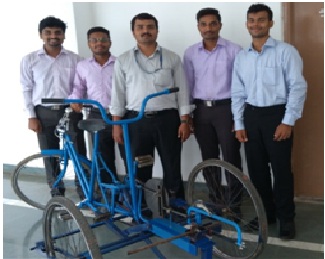
Team Members : Chandan.N, G.Harsha, Nanjundesh.J.M, O.Abdul Rahaman
Project Guide : Mrs. Geethanjali. K.K Assistant Professor
Abstract of the project:
The project concept focuses on minimizing the human efforts by replacing the manual counting with that of this machine. Long hours of continuous counting will reduce the human efficiency and causes strain to the individual both physically and mentally. It also results in errors while counting manually.
Large scale industries use electronics incorporated sophisticated machines which use sensors to enable the counting of the pills. It is highly sophisticated and less prone to errors.
Small and micro scale industries related to Ayurveda and homeopathic science, find it hard to invest for such a sophisticated system. To overcome this situation, this model will be very useful to count the pills at a similar frequency as that of the sophisticated system with minimum investment with very less human errors.
Cost of the project: Rs.8,455/-
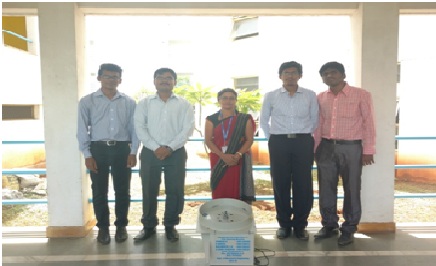
Team Members : Preeti R Harage , Chandan M P , Santhosh R , Mahesha H R
Project Guide :Dr. Keerthiprasad K.S Professor & Head Department of Mechanical EnggVVIET, Mysuru
Abstract of the project:
In this project electrical power is generated as non-conventional method by simply walking or running on the foot step. Non-conventional energy using foot stepneeds no input power to generate the output of the electric power. Fuel deposit will soon deplete by the end of 2050 and fuel scarcity will be maximum. Country like India may not have the chance to use petroleum products. Keeping this dangerous situation in mind we tried to make use of non-pollutant energy resource. The creation of new source of perennial environmentally acceptable, low cost electrical energy as a replacement for energy from rapidly depleting resources of fossil fuels is the fundamental need for the survival of mankind. Proposal for the utilization of waste energy of foot power with human locomotion is very much relevant and important for highly populated countries like India where the roads, railway stations, bus stands, temples, etc. are all over crowed and millions of people move around the clock. In this project the conversion of the force energy into electrical energy. The control mechanism carries the linkages, gear box, A.C generator, and battery. This report consists of various applications and further extension also.
Cost of the project: Rs.10,200 /-
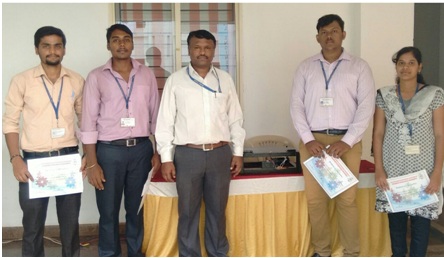
Team Members : Abhinaba Chakraborty, Preetham K, Rahul Syan, Sanju
Project Guide : Dr. Abrar Ahamed, ASSOC. PROFESSOR-MECHANICAL DEPARTMENT VVIET
Abstract of the project:
The Electra-Armadillo Bike is a new kind of two-wheeler. It has a unique ability to blend human and motor power which is fascinating. Electric bikes are ridden by adults of just about all ages and proficiency, on differing rides and for varying purposes.
An electric bicycle, also known as an e-bike, is a bicycle with an integrated electric motor which can be used for propulsion. There are a great variety of different types of e-bikes available worldwide, from e-bikes that only have a small motor to assist the rider's pedal-power (i.e. pedelecs) to somewhat more powerful e-bikes which tend closer to moped-style functionality: all however retain the ability to be pedaled by the rider and are therefore not electric motorcycles. E-bikes use rechargeable batteries and the lighter varieties can travel up to 25 to 32 km/h (16 to 20 mph), depending on the laws of the country in which they are sold, while the more high-powered varieties can often do in excess of 45 km/h (28 mph). In some markets, such as Germany, they are gaining in popularity and taking some market share away from conventional bicycles, while in others, such as China, they are replacing fossil fuel-powered mopeds and small motorcycles.
A folding bicycle is a bicycle designed to fold into a compact form, facilitating transport and storage. When folded, the bikes can be more easily carried into buildings and houses or on public transportation, and more easily stored in compact living quarters or aboard a car, boat or plane. Folding mechanism vary, with each offer a distinct combination of folding speed, folding ease, compactness, ride, weight and durability. Distinguished by the complexities of their folding mechanism, more demanding structural requirements, greater number of parts, and more specialized market appeal, folding bikes may be more expensive than comparable non-folding models. The choice of model, apart from cost considerations, is a matter of resolving the various practical requirements: a quick easy fold, compact folded size, or a faster but less compact model.
Our Electra-Armadillo bike is a fusion of E-bike and foldable bike. It meshes the convenience of transport by means of using electric power as well as the portability of a foldable bike.
Cost of the project: Rs.10,500 /-

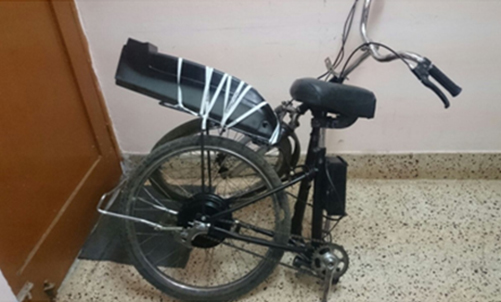
Team Members : Mr. Santhosh K.R, Mr.Santhosh kumar U.T, Mr.Achuth skumar, Mr. T.S Avinash Bopanna
Project Guide : Dr. Keerthiprasad K.S, Professor & Head-Department of Mechanical Engineering VVIET, Mysuru
This project is funded by KSCST
Abstract of the project:
This project is designed to develop composite material using Agricultural Resources and waste materials. The waste materials are hard to disposal and thus a major concern to environmental pollution. Utilization of waste materials could reduce contamination and spaces for disposal. Therefore, recycling of waste material by converting it into green material for application in automobile and construction industries is a prime concern of this project. In this project, Coconut shells ash is blend with aluminium powder to develop light weight metal matrix composites.
Cost of the project: Rs.15,000 /-
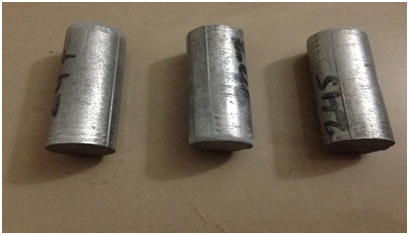
Team Members : Darshan Kumar M S, Naveen Totad T N, Lokesh A R, Siddesh V S M
Project Guide : Dr. N. S. SRIRAM
Abstract of the project:
Projects that are developed in this department are a fusion of new technology and rural orientations. Students are advised to take up projects which are helpful to the rural masses and concentrate and develop ideas and work on projects that cater to the present day energy crisis. Some of the projects carried out by the students are solar operated water pump, Centrifugal Sheller, Small scale packaging equipments like auger filler, Weigh, Fill and Seal packaging machine, etc.,
Students are also involved in the development of computer oriented projects such as development of computer aided heat exchanger design, model of pick and place robot and semi-automatic and automatic packaging equipment. They are encouraged to take up projects on problems prevailing in nearby industries to get a feel on the importance of project work.
Cost of the project: Rs.40,000 /-
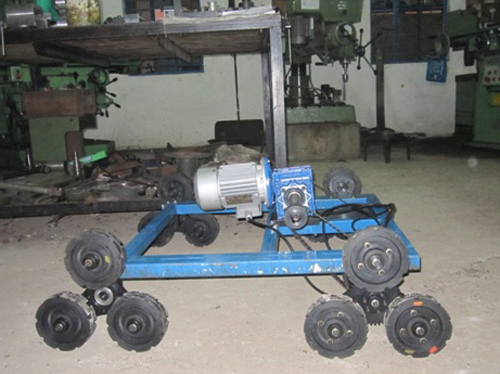
Team Members : Ajay Kulkarni , Anshul Suthar ,Kiran Kumar Bv, Rahul
Project Guide : Dr. N. S. Sriram, Professor and Dean, (Academics) Department of Mechanical Engineering
Abstract of the project:
Robot manipulator or Robot arm is an essential motion subsystem component of robotic system for positioning, orientating object so that robot can perform useful task. In the field of robotics, there are five types of robot configurations that are SCARA, articulated, Cartesian, cylindrical and spherical. In this project, the focus is on 4 Degree of freedom (DOF) articulated arm since it mimic to human arm. Articulated arm consists of revolute joints that allow angular movement between adjacent joint. The arm's rotating base is powered by a single large-scale servo motor. Mounted to the base is an elevation joint, or shoulder, that can move the arm through 180 degrees, from horizontal to vertical on each side. The shoulder uses two large-scale servo motor’s working together to provide the torque needed to lift the rest of the arm, as well as any object that it may be grasping. Attached to the shoulder piece is an elbow that can move through 180 degrees, also powered by a servo motor. The wrist is made up of servos and can move through 180 degrees. Attached to the wrist is a gripper. The revolute geometry allows the robot arm to reach any point within a half-sphere, having the shape of an inverted bowl. The radius of the half-sphere should be the length of the arm when its shoulder, elbow, and wrist are straightened out. The robot arm is controlled by a servo controller circuit board. The servo controller board will be connected to an Arduino Uno Microprocessor.
Cost of the project: Rs 10,800 /-
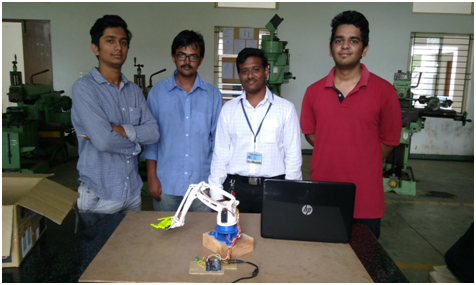
Team Members : P U Kuttapa , Vinay Kumar K R , Vineeth B V , Yash P Bohra
Project Guide :Bharath Shekar H R , Assistant Professor, (Academics) Department of Mechanical Engineering
Abstract of the project:
The project has been carried out tobenefit theworkers and to bring the usage of technology in the agriculture industry that is Agricultural Mechanization. This is vast field to explore. The machine is designed to achieve the following objectives
Cost of the project: Rs.8000 /-
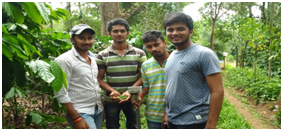
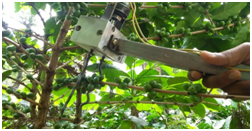
Team Members :Vijaybhoj Raj C M , Darshan R , Prabhanjan R , Saarang Suresh
Project Guide : Dr. Keerthiprasad K S , Prof. and Head Department of Mechanical Engineering Prof. Karthik S Asst. Professor Department of Mechanical Engineering
Abstract of the project:
Sponsored by KSCST (Karnataka State Council for Science and Technology)
Evaporative refrigeration is a concept that was used since ancient times to preserve food items. Evaporative refrigerators are completely natural and do not make use of conventional energy sources of any form. The concept and application gains importance due to the damage that artificial refrigerators cause to the ozone layer, sophistication, expensive, high maintenance and utility costs of conventional refrigerators.
Refrigeration using clay pots has gained prominence in many countries today. These techniques provide refrigeration by evaporative cooling principle without consuming any electricity and are environment friendly. Off late, many improvements in design and materials are being made to popularize this natural refrigeration technique. One of the design is the popular pot-in-pot or Zeer pot design and the second design is one in which an upper chamber is integrated with pot to store water required for evaporation, thereby eliminating the effect of thermal conductivity of sand used in Zeer Pots.
Cost of the project: Rs 12544 /-
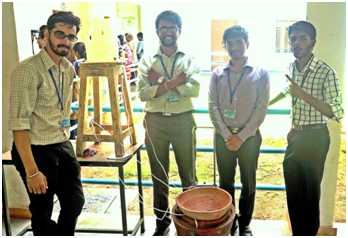
Team Members : Sharath S Pathange , Riyazahmed M N , Akash , Yallaling
Project Guide :Dr. Keerthiprasad K S , Professor Department of Mechanical Engineering
Abstract of the project:
Sponsored by KSCST (Karnataka State Council for Science and Technology)
The aim of this work is to develop a magneto rheological brake (MRB) system that has performance advantages over the conventional hydraulic brake system. The proposed brake system consists of rotating disks immersed in a MR fluid and enclosed in an electromagnet, which the yield stress of the fluid varies as a function of the magnetic field applied by the electromagnet. The controllable yield stress causes friction on the rotating disk surfaces, thus generating a retarding brake torque. The braking torque can be precisely controlled by changing the current applied to the electromagnet. In this paper, an optimum MRB design with two rotating disks is proposed based on a design optimization procedure using simulated annealing combined with finite element simulations involving magneto static, fluid flow and heat transfer analysis.
Cost of the project: Rs.14050 /-
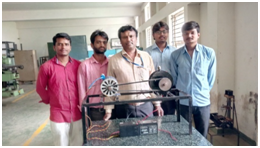
Team Members : Akshay Krishna Ambatt , Bharath V , Ranjan G P , Sangeetha S
Project Guide :Dr. Keerthiprasad K S , Professor Department of Mechanical Engineering
Abstract of the project:
This project is designed to keep clean the drainage system and helps the smooth working of the system. This project automatically cleans the water in the drainage system each time any wastage appears and this form an efficient and easy way of cleaning the drainage system and preventing the blockage.
Waste segregator is designed, fabricated and tested successfully.
In the treatment system of drainage Waste water control by the motor, roller chain and sprocket, lifter and the collecting bin to achieve semi-automatic control of sewage waste water treatment./p>
Drainage wastewater control is treated by this method to irrigate plants, clean toilets, etc.
The cleaner functioned move effectively during the heavier rains which had more volume of running water with garbage and high velocity.
Future Enhancement:
If this project has to be developed and implemented in large scale hen certain design modifications has to be given for this model before production.
Cost of the project: Rs.18000 /-
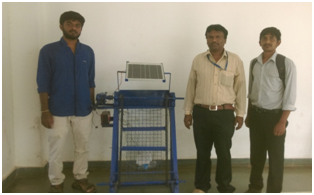
Team Members : Raghu K , Harish Kumar Kc , Bharath Kumara B , Akarsh N
Project Guide : Dr. N. S. Sriram, Professor and Dean, (Academics) Department of Mechanical Engineering
Abstract of the project:
Hover bike is a flying robot, which works with principle of combination of lift generation as in helicopter, and maneuvering of a bike. With this technique humans will experience a new way of flying and driving in mid air. The hover bike can be used for both commercial and military purposes and it has the ability of Vertical Take-Off and landing (VTOL), which is the general way of lift generation by the helicopters and it is equipped with bomb dropping mechanism application. A well designed hover bike will be able to take a slow VTOL due to the low area of pressure distribution by the blades, and also due to high amount of weight concentration mostly near the centre of gravity (C.G) of the body where in almost 60-70% of the total load is placed which includes motor weight, frame weight, battery weight. The main challenge which comes before any engineer making this kind of vehicle would be to overcome the issue of weight in order to have a sustainable lift, which in turn helps in having a pretty good hovering capacity at required amount of height. Designer has to consider a very effective design which is able to overcome any load parameter when working in various conditions. Next concern is the fabrication, the material used for building the equipment. This would require consideration of plenty of parameters to decide which material has to be choosed and also to ensure a better tenure, than any other factors in its comparison.
Cost of the project: Rs.30,585 /-
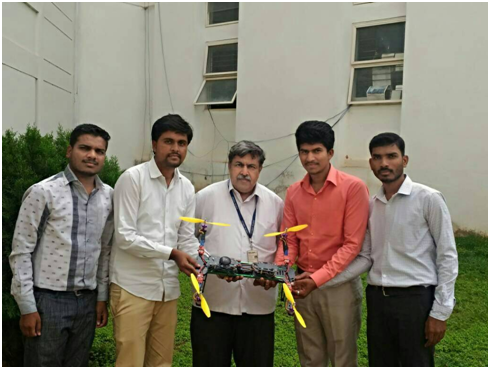
Take a short tour in our campus